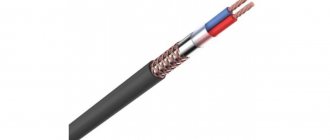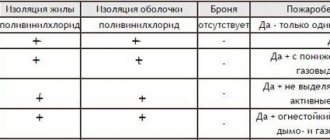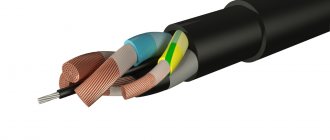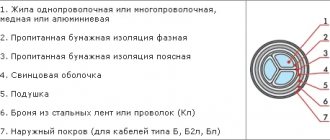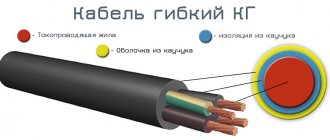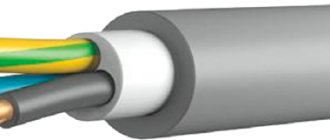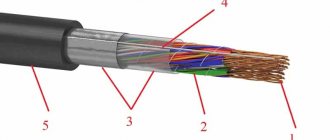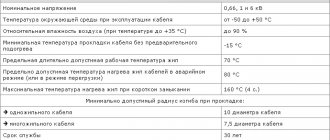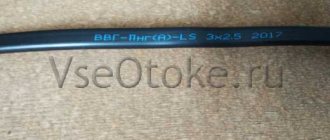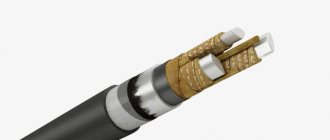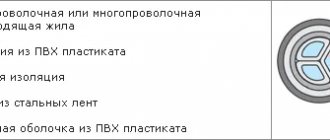Technical characteristics of the NUM cable
Let's start with the fact that various modifications of this cable are produced in Russia.
There are those that comply with German standards (VDE), there are those manufactured according to technical specifications, and as practice shows, each plant has its own specifications. In the second case, the name can be different, here it is NUM, NUM, and NUM. In general, there is no standard. Therefore, often in the market, when buying as if NYM, in fact, a completely different wire is being purchased. In any case, its characteristics may differ from German quality. For example, these are smudges of the compound that fills the interstitial space. The Germans require that this compound be made of chalk-filled rubber. Specifications may contain another material that is less durable and has a low thermal coefficient. Hence the leaks.
Since we started talking about the design, we will continue. So, NUM cable is a power copper conductor. Its conductors can be monolithic if their cross-section is from 1.5 to 10 mm², and consisting of a large number of copper wires, so to speak multi-core, if the cable cross-section is in the range from 16 to 35 mm². At the same time, there are varieties of cable products with different markings:
- NUM-J is a wire with at least three conductors, where one of them must be a grounding conductor, painted yellow-green.
- NUM-O is a cable with at least two cores without a ground wire.
So, the NUM cable consists of copper cores that are insulated with PVC plastic. Next comes a non-flammable layer, it envelops all the veins. And the last layer is general insulation made of the same polyvinyl chloride. Let us add that all the cores inside the cable have different colors, which corresponds to state standards and rules for convenient installation and maintenance.
Other main technical characteristics:
- number of cores: from 2 to 5;
- withstands voltage up to 0.66 kW with a current frequency of 50 Hz;
- This is a flexible cable;
- there is no need to heat during installation;
- installation can be carried out at a temperature not lower than -5C;
- operating temperature: -50С +50С;
- maximum long-term temperature – +70C;
- service life 40 years;
- bend – four wire diameters;
- high resistance to open fire, and NUM wire does not spread flames.
Attention! It is prohibited to use a cable of this brand for laying underground (meaning in trenches).
But laying by air is possible, you just have to take into account the fact that the air is exposed to the negative effects of precipitation, sun and wind. Therefore, in this case, you will have to select the cable according to the current strength with a slight increase in this indicator. For example, if a NUM cable with a cross-section of 1.5 mm² can withstand a current of 30 amperes when laid indoors, then in the air only 24 amperes.
Let us remind you once again that the German VDE standard is very different from the factory specifications, therefore the technical characteristics of cables manufactured according to the specifications will be very different from those manufactured according to the standard. This is especially true for operational safety. For example, if the NUM cable, manufactured according to German requirements, has minor damage, then it can be used. But it is better not to use those manufactured according to specifications, even with minor defects. By the way, German wires must be marked with “VDE” and “NUM”. If this is not found on the cable, then it is a product of Russian manufacturers.
NYM cable most common questions, errors and misconceptions
Home / Reference materials / NYM cable most common questions, errors and misconceptions
In this article we will try to answer all the most common questions that may arise for anyone who wants to purchase an NYM cable. We will also try to dispel all misconceptions that relate to this cable.
1) The most frequently asked question: “Is it possible to use NYM cable for installation in apartments and residential premises?”
Answer: Yes, the NYM cable can be used in installing apartment wiring; you can also use VVG or VVG flat. Installation is possible both along a groove and in a cable channel. But in case of group installation, use VVGng(A) or VVGng(A) LS cable. If increased fire safety requirements are applied in the room, use VVGng(A)FRLS or VVGng(A)LSLTx cable.
2) “NYM gasket in a metal hose yes or no?”
Answer: Based on the standards, the NYM cable is not made as a single-core cable, so laying a cable with 2 or more cores is possible through a metal hose or a metal-plastic pipe.
3) “Is there an analogue of the NYM cable with a large number of cores?”
Answer: According to GOST-R, NYM power cable is manufactured in 2, 3, 4 and 5-core versions. If the number of cores required during installation exceeds five, then use cables with KVVGng LS or KGVVng LS filling.
4) “In everyday life, VVGng and NYM cables are considered identical. Is it true?"
Answer: This question is best answered by the comparative table below:
| Technical data | NYM | VVGng |
| Constant pressure | 660 V | 660 V |
| Frequency | 50 HZ | 50 HZ |
| Regulated number of copper cores | from 2 but not more than 5 | from 1 but no more than 5 |
| Core size | from 1.5 mm2 to 35 mm2 | from 1.5 mm2 to 240 mm2 |
| Minimum and maximum temperature conditions | from -30 Celsius to +40 Celsius | from -50 Celsius to +50 Celsius |
| Maximum temperature when cores overheat | +70 Celsius | +70 Celsius |
| Cable lifespan | up to 40 years old | up to 30 years old |
| Intercore filling | There is | No |
| Resistance to fire propagation | only when laying in one line | possibility of laying cables in a group |
| Application nuances | used for insertion and installation into installations where sealing is required | used for insertion and installation in installations where sealing is not required |
5) “What are the differences between NYM according to the German VDE standard and the many NYM cables according to specifications that have flooded the Russian market?”
Answer: The main visual difference is in the markings that are applied to the surface of the NYM cable. Accordingly, the presence of the VDE mark on the cable gives grounds to consider it manufactured under a license using German technology. The absence of such marking means that the cable is manufactured according to specifications (technical conditions). Manufacturers who produce cables according to VDE are “GK Sevkabel” and “Electrokabel”. The remaining differences relate to the cable structure, which are prescribed for TU cables in GOST 23286. GOST 23286 indicates the established thickness of the insulation and core and the minimum value level for the thickness of the insulation and copper power core. And the VDE standard establishes an average value for the thickness of the insulation and core, which the cable must fully comply with, that is, there are no deviations in manufacturing.
Just look at the example below and you will immediately understand everything.
| Cable type | NYM 3x1.5 | Difference in % | NYM 3x2.5 | Difference in % | NYM 3x16 | Difference in % | |||
| DIN VDE | THAT | DIN VDE | THAT | DIN VDE | THAT | ||||
| Outer shell in mm | 9,4 | 8,9 | 5 | 11,2 | 10.1 | 10 | 20,7 | 18,9 | 8 |
| Cable weight kg/km | 142 | 132 | 7 | 217 | 187 | 14 | 911 | 819 | 10 |
6) “Problems arose after installing the NYM cable in the apartment. The cable releases an oily liquid and the outer sheath cracks. Is this a marriage? And is it worth continuing to operate?”
Answer: The cable market, in particular NYM cables, is oversaturated with various low-quality products. Including various variations on the NYM cable - these are NUM, NUM, NUM, NUMng and others.
The above case is standard for low-quality products according to specifications or without any accompanying documents at all. A clear case of non-compliance with standards during cable production; most likely the problem lies in non-compliance with the ingredient components in the cable insulation. Usually the cable is purchased on the construction market, although sometimes large construction hypermarkets are guilty of this.
In such a situation, “the miser pays twice.” Because cable according to specifications is cheaper, but with it there is a risk of encountering such a problem. Which will lead to a complete replacement of all wiring. Cheaper does not mean better; for cable this axiom is squared.
But it’s worth repeating mistakes, buy a proven NYM Sevcable cable made according to the German VDE standard or a proven NYM cable
Answer: Laying is possible only in a single gasket. In this case, everything will comply with fire safety requirements. But if you want to use a cable channel for several types of cable, then use VVGng(A) or VVGng(A)LS.
Answer: In this case, regulations strongly do not recommend using a cable in a non-armored sheath. That is, by replacing the NYM cable with VBBShV or VBBShVng, you will thus avoid problems in future operation.
9) “In a construction hypermarket I came across two types of NYM cable. One was marked NYM-J and the other NYM-O. Are there any significant differences?
Answer: The only significant difference is the marking of the grounding conductor in the NYM-J cable in yellow-green color. NYM-O there is no grounding conductor and the neutral conductor is highlighted in blue.
10) “Can I use NYM in a room with high humidity and high average temperature? I am planning wiring in a bathhouse made of a wooden frame.
Answer : Installation standards do not prohibit the use of NYM cable in damp and warm rooms. The only caveat is that the temperature should not exceed + 50 degrees Celsius, which may be difficult to do if YOU run the cable openly in a steam room.
Share on social networks:
Design features
VVGng is a power cable with copper conductors. The core insulation is made of polyvinyl chloride plastic. The insulation material contains additives that make it flame retardant. This conductor is available with a number of cores from 2 to 5. For ease of installation, the core insulation is color-coded, which can be done by completely painting the core insulation, or with a colored stripe. The outside of the cable is covered with a sheath made of the same PVC plastic as the core insulation. The core can have a single-wire or multi-wire design. The cross-sectional shape of the core can be round or segmented.
NYM is the designation of an analogue of the Russian product brand VVGng, produced according to the German standard VDE 0250. The number of cores also varies from 2 to 5. The insulation material is the same polyvinyl chloride, which does not support combustion. The main design difference between this product and its Russian counterpart is the presence of an additional non-flammable seal between the core insulation and the outer sheath of the cable.
NYM marking designation
NYM electric power cable is manufactured in compliance with various technical regulations in force in Russia and other countries (TU, GOST, VDE, DIN, etc.). Depending on this, the marking changes.
The decoding of the name looks like this:
“N” – standard type of cable according to the German classification;
“Y” – insulation made of PVC plastic;
“M” is a product with a special external coating.
Copper is used as a conductor, as evidenced by the absence of the letter “A” in the name.
Technical parameters of NYM cable products:
- design of 2-4 or more copper cores;
- fire protection class LS (does not support combustion, products are resistant to open fire);
- high levels of flexibility (the cable is designed for installation of electrical wiring without preheating);
- variability of core diameter (minimum - 1.5 mm).
Color coding
NYM cable produced in Russia or imported from Europe, if it is not a fake, always has color marking of conductor insulation that complies with the standards of Russian PUE (Electrical Installation Rules).
The colors of their internal insulation may vary depending on the number of cores.
- Single-core - color is not regulated.
- Twin-core type O - black and blue.
- Three-core type O - black, brown and gray.
- Four-wire type O - black, brown, gray, blue.
- Three-core type J - black, blue, yellow-green.
- Four-wire type J - black, brown, gray and yellow-green.
- Five-core type J - black, brown, gray, blue and yellow-green.
By color marking you can easily determine the purpose of this particular cable. The conductor in the blue sheath is always zero in single-phase networks or neutral in three-phase networks. Yellow-green is a well-known designation for an “earth” conductor. All other colors indicate phases.
Please note: NYM cable, made in accordance with GOST 22483, which regulates the standards of such products, cannot have a conductor in white or white-blue insulation. If the wire you are embroidering contains a white core, this is a fake. You can use it only at your own peril and risk.
Explanation of the name
The decoding of the name NYM cable goes back to the old German classification system, according to the German national standard VDE 250, part 204. Currently, the European Union has a different marking system on a pan-European scale, but NYM at one time gained such wide popularity that it was able to maintain the authentic the name by which most European and Russian consumers know it.
So, the marking means the following:
- N - the product complies with the German standard VDE 250;
- Y - insulation is made of polyvinyl chloride;
- M - there is an outer protective shell.
There are two main subtypes of this wire - NYM-J and NYM-O. The letter J indicates the presence of a yellow-green wire in the product, intended for connecting the “ground”. O - for the absence of it. In this case, O may not be indicated on the marking of the coil or on the outer sheath of the cable; J is always indicated. Thus, NYM-J is a cable with a “ground” conductor, just NYM is without it.
Also, each wire of the NUM type is marked with the type 3×2.5, 1×4, and so on. This is a typical marking of the number of cores and their cross-section. The first number is the number of conductors, the second is the cross-section in square millimeters.
Note: a wire of this type can have from 1 to 7 cores of a wide range of cross-sections, up to 2.5 mm square. Some manufacturers, in particular Sevkabel, provide the service of manufacturing wires of the NYM standard with conductors of a larger cross-section - according to the customer’s needs.
NYM-J cable design elements:
- Core: single-wire or multi-wire copper conductor.
- Insulation: polyvinyl chloride (PVC) plastic compound.
| 1 | Number of cores | NUM-J NUM-O |
| 2 | – | Black, blue |
| 3 | Green-yellow, black, blue | Black, blue, brown |
| 4 | Green-yellow, black, blue, brown | Black, blue, brown, black |
| 5 | Green-yellow, black, blue, brown, black | Black, blue, brown, black, black |
- Internal filling: unvulcanized rubber, highly filled plastic compound or thermoplastic elastomer.
- Outer shell: polyvinyl chloride plastic compound in grey, black or white.
The NYM-J cable uses internal filling made of unvulcanized rubber, highly filled plastic compound or thermoplastic elastomer, which:
- * prevents the risk of cracking during operation in unfavorable conditions,
- * allows you to easily and conveniently “cut” the cable during installation,
- * increases cable flexibility,
- *gives the cable a round shape.
Description and design of NYM power cable
NYM is a power cable with copper conductors with insulation and a sheath made of PVC plastic with additional filling of elastic material between the twisted conductors and the sheath.
The letter “J” is added through a hyphen to the designation of a cable that has a yellow-green grounding conductor; the letter “O” is added to the designation of a cable that does not have a grounding conductor.
NYM cables can have from one to seven cores with a cross-section from 1.5 mm2 to 35 mm2. Cores with a cross-section of up to 10 mm2 are made monolithic, with a cross-section of 16 mm2 and above - twisted from individual wires. All cores in the cable are made of the same cross-section. Single- and two-core cables are made only in the “O” version (without a grounding conductor), the rest - both with and without a grounding conductor.
The insulated cores must have the distinctive colors indicated in the table.
| Number of cores | With grounding conductor | Without ground wire |
| 2 | Black, blue | |
| 3 | Yellow-green, black, blue | Brown, blue, black, |
| 4 | Yellow-green, black, blue, brown | Black, blue, brown, black |
| 5 | Yellow-green, black, blue, brown, black | Black, blue, brown, black, black |
Insulated cores of NYM cables with more than one core must be twisted. On top of the twisted cores, under the sheath, there must be a layer of elastic material, which should fill the gaps between the cores, covering them with a certain thickness, and give the core a round shape. As a rule, the intermediate layer is made of unvulcanized chalk-filled rubber.
The color of the NYM PVC cable sheath is light grey. The insulated cores, intermediate layer and sheath should be easily separated when cutting. For this purpose, as well as to facilitate the removal of the shell by cutting and breaking off, an increased amount of chalk is added to the PVC shell plastic compound.
The design parameters of individual cable sections are given in the table.
| Cable cross-section | Nominal insulation thickness, mm | Nominal thickness of the intermediate layer, mm | Nominal shell thickness, mm | Nominal cross-section, mm2 | |
| Minimum | Maximum | ||||
| 2x1.5 | 0,6 | 0,4 | 1,4 | 8,4 | 9,8 |
| 2x2.5 | 0,7 | 0,4 | 1,4 | 9,8 | 11 |
| 3x1.5 | 0,6 | 0,4 | 1,4 | 8,8 | 10,5 |
| 3x2.5 | 0,7 | 0,4 | 1,4 | 10 | 11,5 |
| 3x4 | 0,8 | 0,4 | 1,4 | 11,5 | 13 |
| 4x1.5 | 0,6 | 0,4 | 1,4 | 9,5 | 11 |
| 4x2.5 | 0,7 | 0,4 | 1,4 | 11 | 12,5 |
| 4x4 | 0,8 | 0,4 | 1,6 | 12,5 | 14,5 |
| 4x6 | 0,8 | 0,6 | 1,6 | 14,5 | 16,5 |
| 5x1.5 | 0,6 | 0,4 | 1,4 | 9,9 | 12 |
| 5x2.5 | 0,7 | 0,4 | 1,4 | 11,5 | 13,5 |
| 5x4 | 0,8 | 0,6 | 1,6 | 14 | 16,5 |
| 5x6 | 0,8 | 0,6 | 1,6 | 15,5 | 18 |
Scope of application of NYM-J cable:
Used for installation of electrical wiring of cable lines:
- * In industrial, residential and public buildings
- * Can be used over, in and under plaster
- * In brickwork and concrete.
- * Outdoors, out of direct sunlight.
- * Laying can be carried out in pipes and channels.
- * The cables are designed for use in light conditions where there are no mechanical loads.
The service life of the NYM-J cable is 30 years. Total reviews: 0 – Write a review 0r.
Application area
This type of wire is intended exclusively for internal electrical wiring. The fact is that PVC plastic is not resistant to radiation in the ultraviolet spectrum, which is present in sunlight. It decomposes under the influence of ultraviolet radiation, so if it is necessary to stretch the NYM cable in an open place, it must be enclosed in a steel or plastic corrugated pipe.
This cable is used for power and lighting wiring inside any structures, including the first class of electrical safety. They can connect single-phase and three-phase current consumers in rooms with explosion hazard classes B1 b, B1 g and Vpa. In areas with explosion hazard class B1a it can also be used, but exclusively for lighting.
NYM cable manufacturers
Well, the last thing I would like to talk about is which NYM manufacturer is better to choose. Among foreign manufacturing plants, the leaders are Helukabel, Lapp Kabel and TKD Kabel (Germany). Products from manufacturers DENIZLI CABLE LTD (Turkey) and Nexans (France) are also of high quality.
Among the domestic manufacturers of NYM cable, we can recommend such factories as Sevkabel, Kamkabel and Pskovkabel, whose products have passed all certificates of conformity and meet all TU and GOST standards.
We draw your attention to the fact that in recent years, counterfeits have begun to appear more and more on the market of electrical products. In your case, we strongly advise you to avoid products marked “NUM” and “HUM”, as in the photo below!
That's all I wanted to tell you about the technical characteristics of the NYM cable. Having studied the conductor markings, scope and purpose, you can now accurately decide whether to buy this product option for your own electrical installation work.
NYM and NUM cables: what's the difference?
High technical characteristics make the NYM cable in demand for stationary installation of electrical circuits with a frequency of 50 Hz and a voltage of 660 V. It is recommended by many professional electricians, since the products comply with strict German standards, technological regulations and documentation regulating electrical wiring work. Copper cable produces almost no smoke when exposed to open fire.
NYM is produced in accordance with VDE 088253 and VDE 0250 part 204. These are German standards that the Electrical Engineers Union works with. Among domestic companies, only SevKabel adheres to these technical requirements. “Pskov Cable and other enterprises use Russian specifications, releasing a clone to the market - cable brand NUM (NUM). Because of this, products have significant differences in insulation thickness, safety parameters and other characteristics.
The difference between NYM and NUM cable products lies, first of all, in the capabilities and efficiency of application. The latter has less reliable insulation and winding, as well as lower quality copper. At the same time, it fully complies with domestic standards and is produced at state enterprises, therefore it is sold on the market legally. If you do not have the funds to purchase the original NYM cable (its price varies depending on the country of origin, since there is a difference in customs duties), you can get by with its domestic analogue NYM. The main thing is to check for certification and purchase the product from a reliable manufacturer.
In order not to doubt which cable is better to choose, you need to analyze the installation conditions. If there is a risk of minor damage during installation, NYM should be preferred. When there are no such concerns, you can use a cheap Russian clone of NUM, which has similar characteristics, but lower security parameters.
Advantages of NUM cable
- High elasticity. In principle, this is one of the reasons for the high popularity of the conductor. It is easy to install in hard-to-reach places.
- Sufficiently high fire safety of operation. The NUM wire does not support combustion, but laying it in a bundle is still not recommended.
- The characteristics described above allow the use of this type of electrical wiring in wooden buildings.
- The color design of the cores meets the standards.
The better NYM
- increased elasticity - easier wire laying, reducing installation time for long or complex electrical routes;
- the presence of an intermediate layer - seals the electrical conductors and simplifies the pre-assembly cutting of the product;
- properties of the material of the insulating layer and shell - does not support the spread of fire when installed alone or installed in a group;
- ideal quality - manifested, for example, in 100% identicalness of the actual cross-section of conductors and sheaths to the indicators specified in the technical documentation for the wire;
- impeccable reputation in the professional environment - many experts recommend using NYM in projects permitted by standards.
Operating and installation conditions
- Operating temperature – from -50 to +50 °C;
- The minimum service life of the NYM cable under normal operating conditions is 30 years;
- The main areas of application are indoor and outdoor installations. Outdoor use is only possible outside of direct sunlight.
- It is possible to lay the cable on top of, in and under plaster in dry, damp and wet rooms, as well as in brickwork and concrete, with the exception of direct pressing into vibro-filled and stamped concrete.
- Installation can be carried out in pipes, in closed installation and curved channels; gasket temperature – not lower than -5 °C;
- The size of the mounting bends is at least 4 shell diameters.
Description and decoding of the NYM cable
NYM power wire is a cable product that is widely used in stationary power, as well as lighting industrial and household networks with voltages up to 0.66 kV at frequencies of 50 Hz.
Installation of
NYM power cable is possible both inside dry, damp, wet rooms, and in open space, subject to a sufficient level of protection from mechanical damage and solar ultraviolet radiation (in cable ducts, metal hoses or corrugated pipes).
It is permissible to lay the wire under or on top of plaster, in brickwork or in concrete. Direct pressing of the cable into stamped or vibration-filled concrete is strictly prohibited. Explanation of the NYM marking:
· N
– compliance with the German cable product classification standard Normenleitung,
· Y
– the insulating layer is made of polyvinyl chloride (PVC plastic),
· M
– installation in different conditions is possible.
Additionally, the VDE mark must be present on the wire insulation, which indicates that the cable is manufactured according to the German industry standard Veiband Deutscher Electrotechniker 0250 and is approved for use in areas with an increased risk of fire, for example, in wooden buildings.
KG – designed for harsh conditions
Perhaps the best solution for outdoor use is a cable marked KG. It has an insulating layer of rubber based on natural rubber. Moreover, such insulation is used both outside and for the cores themselves. This helps the product maintain high flexibility even in severe frost, and also makes it resistant to ultraviolet radiation - the shell does not crack. Withstands high air humidity. It is suitable for outdoor lighting of cottages, private houses, and enterprises. Can be used in car washes and production areas. It is often the basis for creating extension cords and powering equipment.
Understanding the labeling
- K – cable
- G – flexible
It has copper cores - from 1 to 5 pieces. The cross section can be up to 95 square meters. mm. For example, the 3x4 marking means that the cable is three-core and the cross-section of the cores is 4 square meters. mm. There are also additional letter designations: t – the cable is suitable for tropical zones and rooms with air humidity up to 98%; n – non-flammable with oil-resistant insulation; chl – resistant to cold, withstands frosts down to -60 °C.
What errors occur when using NYM cable
NYM wire is mainly recommended for installation work in buildings in the construction of which wood or flammable materials were used.
It must be remembered that the wire does not spread fire only when individually laid. If you need to use a group gasket, then it is advisable to purchase products from other brands that are intended for this type of work.
Many people are faced with the problem of laying wires in baths, saunas or steam rooms. It is allowed to install this wire in such premises. Because the rubber layer fits tightly to the wire insulation, thereby preventing moisture from penetrating into the cable. These are the only problems that may arise when using the product.
Classification and price
Cables are available with different numbers of cores. Their number is from 1 to 5. Some enterprises produce products with the number of cores up to 7. The wire also differs in the cross-sectional area of the conductors, ranging from 1.5 to 6 square meters. mm.
The level of prices depends on the characteristics of the cable and the pricing policy of the selling company. The cost ranges from 20 to 500 rubles per linear meter, taking into account the characteristics of the wire and the above conditions. By purchasing products in bulk, the client can receive a discount.
VVG – a safe solution for residential premises
If you ask electricians what is the most common type of cable for residential buildings, they will answer - VVG. This is the most popular solution for internal electrical networks and closed electrical installations with voltages up to 1 kV. The maximum service life is 30 years. This type of cable replaced PVS as more reliable. But at the same time, this is one of the most budget options on the market, which is why it is in such great demand.
Understanding the labeling
- B – PVC core insulation
- B – PVC outer sheath
- D – there is no external armor or other additional protective layers
It uses copper cores, which can be from 2 to 5 pieces. The manufacturer also indicates the cross section. For example, 3x2.5 indicates the presence of three cores and a cross-section of 2.5 square meters. mm.
There are several varieties in this category of electrical products:
- VVGng - does not propagate combustion due to special additives in the insulating layer; several cables can be laid in one channel without additional protection of each with corrugation;
- VVGng-ls is a non-flammable cable that produces a low amount of smoke when melted, therefore ideal for residential premises;
- VVGng-frls is perhaps the safest cable in this category, as it does not support combustion, has a low level of smoke generation, is resistant to high temperatures and even open fire, all thanks to additional mica insulation.
NYM cable: description of advantages
The nym cable has very good reviews. And for good reason! After all, such an invention has a lot of advantages. It is NUM that is considered the safest and highest quality cable.
The NUM cable is a European brand wire, so it has high quality and a long service life. If you are not confident in your ability to install current, then it is better to let a real master do such work.
Numovsky wire is a real find for a person who wants to make his home as comfortable and safe as possible. So that you can verify this, we will give you some of its advantages.
Advantages of NUM wire from a European manufacturer:
- The NUM cable has high flexibility and ductility. This is due to the presence of rubber insulation in its composition. Thanks to it, you can install wiring even in the most difficult to reach places.
- This wire has excellent fire resistance. All thanks to the non-flammable coating. However, if you lay this wire in bundles, the chance of fire will increase significantly.
- The NUM cable is very flexible and fireproof, so it is an ideal option for installing wiring in a wooden house.
- You can lay this type of cable not only indoors, but also on the ground or along overhead columns.
- Each of the conductors of the NUM wire has its own color. The colors of the wires in such a cable always correspond to the diagram. This nuance will significantly simplify repair work related to the position of the cable.
The NYM cable has a lot of advantages, for which most users love it. This accessory meets all international requirements and has quality certificates.
NYM – confidence for many years
This is a German analogue of the VVG cable. Only it is manufactured in accordance with the German standard DIN VDE Normenleitung. It is characterized by high reliability, safety and long service life - up to 40 years. It is most often chosen for installation in apartments, cottages, office buildings, commercial and industrial premises. Many manufacturers offer frost-resistant cables, the operating temperature of which can reach -50 °C. Therefore they are suitable for installation in unheated rooms.
Also, the NYM sheath is not afraid of ultraviolet radiation, unlike VVG - you can install the cable where direct sunlight hits. It is also easy to cut without special tools, which electricians appreciate.
Understanding the labeling
- N (normenleitung) – manufactured according to VDE standard
- Y (ysolationsschicht) – polyvinyl chloride insulation
- M (mantelleitung) – there is an outer shell
This type of cable can have from 1 to 7 copper cores. The cross section can reach 6 square meters. mm. You can find a product marked ls (low smoke), which means reduced smoke production when heated. The letter J indicates the presence of a yellow-green protective ground conductor. If there is no letter after the name or there is the letter O, this means there is no grounding conductor.
Device Features
- The outer sheath of the cable is made of polyvinyl chloride.
- Between the outer shell and the cores there is an intermediate layer of non-flammable sealant - chalk-filled rubber.
- Current-carrying conductors are insulated with polyvinyl chloride insulation.
- The number of cores can be from 1 to 5.
- The cores are made of copper and can consist of either one wire or several wires, depending on the cross-section.
- Color markings comply with international standards. According to domestic rules, the ground wire must have a yellow-green color. It is allowed to make the sheath of the ground wire pure green or yellow. Phase conductors can be painted in different colors.
What is the difference between NYM and VVGng
The NYM cable will be useful only for single installations. If you are planning a group session, then it is better to make a choice in favor of VVG. Structurally, both products consist of several copper cores with polyvinyl chloride insulation and the same outer shell. However, only VVGng (the prefix “ng” indicates the non-flammability of the cable) is able to stop the flame and prevent its spread during group installation of several conductors.
We list the main technical and operational characteristics of NYM and VVGng and compare them in the table below:
| NYM | VVGng |
| 660 V | 660 V |
| 50 Hz | 50 Hz |
| 2-5 pcs. | 1-5 pcs. |
| 1.5-35 sq. mm | 1.5-240 sq. mm |
| 40 years | 30 years |
| Present | Absent |
| Single gasket only | Any gasket, including group gasket |
| Moisture protection, not UV resistant | Can be used in any situation |
NYM Power Cable Specifications
- Number of cores: 2-5,
- Cross section 1.5-10 mm for single-wire wires, 16-35 mm for multi-wire wires,
- Ambient temperature: -30 to +40 °C,
- Lowest temperature at which installation is possible: -5 °C,
- Air humidity at 35 °C: 98%,
- Operating voltage: 660V (50Hz),
- AC test voltage (50 Hz) for 5 min: 2 kV,
- Minimum bending radius: 4 days along the shell,
- Does not support the combustion process in a single installation; for a group installation it is better to use the NYMng or NYMng-LS version,
- Does not tolerate ultraviolet rays well
- Service life: from 30 years, warranty - up to 5.
Other technical characteristics of the NYM power cable directly depend on the cross-section of the conductor and are given in Table 2.
table 2
| Number of cores x section mm.kv | Outer diameter, mm | Cable weight, kg, km | Diameter of conductor, mm | Diameter of insulated core, mm | Max. electr. resistance TPJ post. current (at +20 C ° ), Ohm/km | Electr. resistance DC insulation current (at core t ° +70 ° C), MOhm/km |
| 2x1.5 | 8,5 | 120 | 1,35 | 2,56 | 12,1 | 0,010 |
| 2x2.5 | 9,7 | 165 | 1,74 | 3,14 | 7,41 | 0,0094 |
| 2x4 | 11,5 | 230 | 2,24 | 3,84 | 4,61 | 0,0087 |
| 3x1.5 | 9,0 | 140 | 1,35 | 2,56 | 12,1 | 0,010 |
| 3x2.5 | 10,2 | 190 | 1,74 | 3,14 | 7,41 | 0,0094 |
| 3x4 | 12,0 | 270 | 2,24 | 3,84 | 4,61 | 0,0087 |
| 4x1.5 | 9,6 | 165 | 1,35 | 2,56 | 12,1 | 0,010 |
| 4x2.5 | 11,2 | 230 | 1,74 | 3,14 | 7,41 | 0,0094 |
| 4x4 | 13,5 | 340 | 2,24 | 3,84 | 4,61 | 0,0087 |
| 5x1.5 | 10,3 | 190 | 1,35 | 2,56 | 12,1 | 0,010 |
| 5x2.5 | 12,0 | 270 | 1,74 | 3,14 | 7,41 | 0,0094 |
What to consider when choosing a cable
Within each described category there are subtypes, and you have probably already decided on the most suitable cable for your requirements. But there are also general tips that guide your purchase.
- First, consider the voltage. In a household network its value is 220 - 230 V, in an industrial network - 380 V and higher. Here you will find a cable for both needs. The main thing is to pay attention to the number of cores.
- Secondly, calculate the cross section. It depends on the type of gasket - open or closed, current strength and connected power. If you do not know these parameters, it is better to contact an electrician. And according to his calculations, order the required cable.
- Thirdly, pay attention to which document the cable is made from. In Russia this may be TU or GOST. If the installation will take place at an enterprise where the parameters of the electrical network are strictly controlled, it makes sense to give preference to GOST.
- Fourthly, calculate the length and decide how it will be more convenient to buy the required quantity. Manufacturers offer cable in a coil, coiled, on a reel and cut to individual lengths.
- Fifth, consider the country of production. You can purchase products from China, Russia, Europe and the USA. Products differ in price, workmanship and warranty.
If you need advice on selection, please contact our managers. They will help you choose the right cable and guide you through the parameters.
Manufacturers NYM
NYM cable is produced at foreign and domestic enterprises. The most popular factories in our country are:
- "Sevkabel";
- "Technoton";
- "Concord";
- "Pskovkabel";
- "Kamkabel".
Any products of these enterprises undergo all necessary stages of certification in accordance with international quality standards. For foreign companies, we will highlight the German TKD Kabel, Lapp Kabel and Helukabel, the French Nexans and the Turkish Denizli Cable.
NYM is stored and transported in special coils or drums, the diameter of which can be eight times the thickness of the cable itself. During storage, it is better to use a hard-to-reach and closed place, the minimum temperature of which is not lower than -15 degrees. Celsius. Also be sure to avoid direct exposure to direct sunlight.
